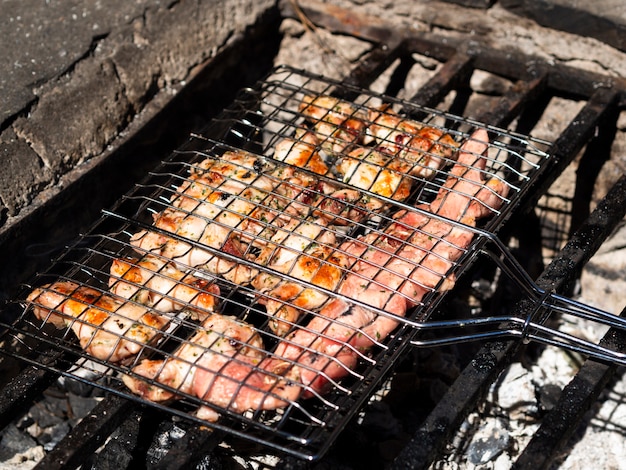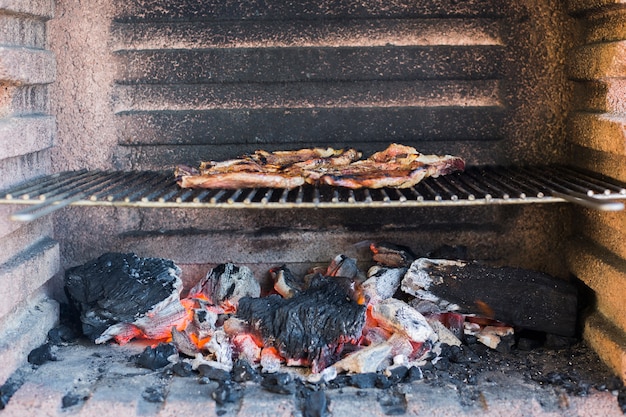What temperature is indirect grilling?
Indirect grilling is a popular cooking technique used to prepare a wide variety of dishes, including meats, vegetables, and even desserts. It involves cooking food using indirect heat rather than directly over an open flame. This method allows for slower and more even cooking, resulting in tender and flavorful results.
To achieve the perfect indirect grilling temperature, it is important to understand the ideal range for different types of food. Generally, the recommended temperature for indirect grilling falls between 225°F (107°C) and 275°F (135°C). However, it is worth noting that these temperatures can vary depending on the specific dish you are preparing.
The science behind indirect grilling
Indirect grilling works by creating a two-zone fire setup on your grill. One side of the grill is heated directly by the flames (the direct heat zone), while the other side is left without direct flame contact (the indirect heat zone). By positioning your food on the indirect heat side, you can slowly cook it without risking charring or overcooking.
Creating the perfect indirect heat zone
There are several methods to create an indirect heat zone on your grill. One common technique involves having a two-burner gas grill, lighting only one burner, and placing the food on the unlit side. For charcoal grills, you can arrange the charcoal on one side and place the food on the opposite side.
The ideal temperature for different foods
While the general temperature range for indirect grilling falls between 225°F (107°C) and 275°F (135°C), there are some guidelines to consider based on the type of food you are cooking. Here are a few examples:
- Meat: For larger cuts of meat, such as roasts or whole chickens, aim for a temperature of around 225°F (107°C). This slow cooking method allows for the breakdown of connective tissues, resulting in tender and juicy meat.
- Poultry: Chicken and turkey can be cooked at slightly higher temperatures, between 275°F (135°C) and 325°F (163°C). Ensure the internal temperature reaches a safe level to avoid any foodborne illnesses.
- Fish and seafood: Delicate fish fillets and seafood benefit from higher temperatures, around 325°F (163°C) to 375°F (190°C), for a shorter cooking time.
- Vegetables: Vegetables generally cook faster than meats and can be grilled at higher temperatures. Aim for around 350°F (175°C) to 400°F (204°C) to achieve a tender-crisp texture.
Remember to always follow specific recipes and guidelines for different dishes, as cooking times and temperatures may vary.
Tips for successful indirect grilling
To ensure your indirect grilling experience is a success, here are a few tips to keep in mind:
- Preheat your grill: Allow your grill to heat up properly before placing your food on the indirect heat zone. This helps maintain a consistent cooking temperature throughout the process.
- Use a thermometer: Invest in a reliable meat thermometer to accurately monitor the internal temperature of your food. This ensures it is cooked to perfection and eliminates any guesswork.
- Consider adding smoke: Indirect grilling provides an excellent opportunity to infuse your food with smoky flavors. Experiment with different types of wood chips or chunks to enhance the taste.
- Baste and season: During the cooking process, baste your food with flavorful marinades or sauces to keep it moist and add extra taste. Don’t forget to season your dishes with herbs, spices, and rubs before grilling.
- Practice patience: Indirect grilling is a slower cooking method compared to direct grilling. It requires patience and attention to detail to achieve the desired results. Resist the temptation to rush the process.
So, whether you’re planning to grill a mouthwatering brisket, roast vegetables, or smoke a tender rack of ribs, understanding the ideal temperature for indirect grilling is key. With the right heat setup, temperature control, and a little practice, you’ll be able to master this cooking technique and impress your family and friends with delicious grilled creations.
What temperature is Weber indirect cooking?
When it comes to cooking on a Weber barbecue, one popular technique is indirect cooking. This method involves creating two heat zones within the grill – a hot zone and a cool zone – allowing you to cook your food more slowly and evenly. But what temperature should you aim for when using this technique?
Typically, for indirect cooking on a Weber barbecue, you’ll want to aim for a temperature range of 225°F to 275°F (107°C to 135°C). This low and slow cooking method is perfect for roasts, ribs, and other cuts of meat that benefit from a longer cooking time.
However, it’s important to note that the exact temperature you choose will depend on the specific recipe you’re following and the type of meat you’re cooking. It’s always best to consult a reliable recipe or cooking guide to determine the ideal temperature for the dish you’re preparing.
Benefits of indirect cooking
Indirect cooking on a Weber barbecue offers several benefits. Firstly, it allows for more even cooking as the heat circulates around the food rather than directly underneath it. This helps to prevent burning or charring, resulting in perfectly cooked and tender meat.
Additionally, indirect cooking is ideal for cooking larger cuts of meat that require longer cooking times. The low temperature and slow cooking process help to break down tough connective tissues, resulting in succulent and flavorful dishes.
How to set up your Weber barbecue for indirect cooking
- Clean your grill and preheat it to the desired temperature range using a two-zone setup.
- If using a charcoal grill, arrange the lit coals on one side of the grill, creating a hot zone. Place a drip pan filled with water or another liquid on the other side. The food will be placed on the cool side of the grill.
- If using a gas grill, light one burner and place the food on the unlit side. Adjust the burner to maintain the desired temperature.
What temperature is direct grilling?
Direct grilling is a popular cooking method that involves placing food directly over the heat source. Whether you are cooking steak, burgers, or vegetables, getting the right temperature is key to achieving delicious results. In the UK, where barbecuing is a beloved pastime, understanding the ideal temperatures for direct grilling can help you master this cooking technique.
Why temperature matters
Temperature plays a crucial role in direct grilling as it determines how your food will cook. Different foods require different heat levels to achieve the desired level of doneness and flavor. For example, cooking a steak at too low of a temperature will result in a tough and undercooked piece of meat, while cooking it at too high of a temperature can cause it to burn on the outside while remaining raw on the inside.
Recommended temperatures for direct grilling
The optimal temperature for direct grilling varies depending on the type of food you are cooking. Here are some general guidelines:
Steak: Preheat your grill to a high heat of around 450°F to 500°F (232°C to 260°C) for a perfectly seared exterior and medium-rare interior.
Burgers: Cook your burgers on a medium-high heat of around 375°F to 450°F (190°C to 232°C) to ensure they are cooked through without burning the outside.
Vegetables: Grilling vegetables generally requires a medium heat of around 350°F to 400°F (177°C to 204°C). This allows them to soften and caramelize without becoming overly charred.
Tips for achieving the right temperature
Here are a few tips to help you achieve the right temperature for direct grilling:
- Invest in a reliable grill thermometer to accurately monitor the heat of your grill.
- Preheat your grill for at least 10-15 minutes before cooking to ensure it reaches the desired temperature.
- Adjust the heat as needed during cooking by moving the food closer to or further away from the heat source.
By understanding the ideal temperatures for direct grilling and following these tips, you can elevate your outdoor cooking game and impress your friends and family with perfectly grilled dishes.
What Temperature is Indirect Heat for Steak?
If you’re a steak connoisseur, you know that the method of cooking can greatly impact the taste and tenderness of your steak. One popular cooking technique is using indirect heat. Indirect heat involves cooking the steak away from direct flames or heat sources, allowing for a more gentle and even cooking process.
But what temperature should you use when cooking steak with indirect heat?
The Ideal Temperature
When using indirect heat to cook steak, it’s recommended to maintain a grill temperature of around 225-275°F (107-135°C). This lower temperature allows for a slower cooking process, resulting in a more tender and juicy steak.
Benefits of Indirect Heat
- Tenderizing: Cooking steak with indirect heat helps to tenderize the meat by slowly breaking down connective tissues, resulting in a more flavorful and tender steak.
- Even Cooking: Indirect heat ensures that the steak cooks evenly throughout, minimizing the risk of overcooking or drying out the edges.
- Smoke Flavor: Using indirect heat on a grill or smoker allows for the incorporation of smoky flavors into the steak, enhancing its overall taste.
How to Cook Steak with Indirect Heat
- Preheat your grill to the desired temperature (225-275°F).
- Season your steak with salt, pepper, and any other desired seasonings.
- Place the steak on the side of the grill without direct heat, ensuring it is not directly over the flames or burners.
- Cook the steak for the desired amount of time, flipping it occasionally to ensure even cooking.
- Use an instant-read meat thermometer to check the internal temperature of the steak. For medium-rare, aim for an internal temperature of around 135°F (57°C).
- Once cooked to your desired level of doneness, remove the steak from the grill and let it rest for a few minutes before serving.
Indirect heat cooking is a fantastic technique for achieving a perfectly cooked steak. By maintaining a lower temperature and avoiding direct heat, you’ll be rewarded with a tender and flavorsome dish that will impress your friends and family.
Conclusion
“Indirect cooking on a Weber barbecue provides the perfect method for achieving tender and flavorful dishes. With a temperature range of 225°F to 275°F, this low and slow cooking technique allows for even cooking and great results every time.”
Whether you’re grilling up ribs, roasts, or even delicate fish fillets, mastering indirect cooking on your Weber barbecue is a fantastic way to take your outdoor cooking skills to the next level.


